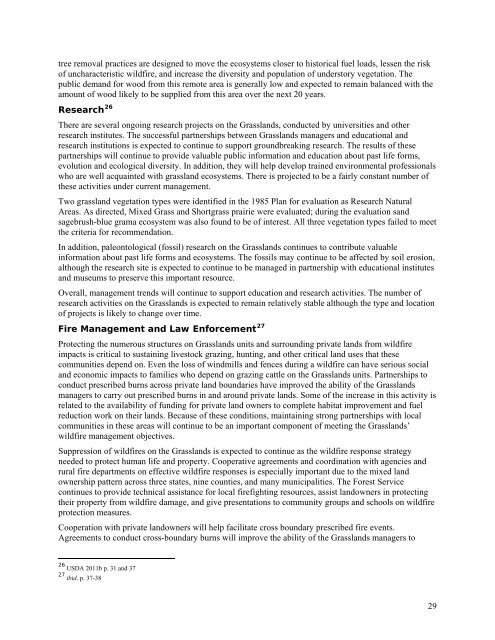Comprehensive Evaluation Report
Comprehensive Evaluation Report
Comprehensive Evaluation Report
Create successful ePaper yourself
Turn your PDF publications into a flip-book with our unique Google optimized e-Paper software.
tree removal practices are designed to move the ecosystems closer to historical fuel loads, lessen the risk<br />
of uncharacteristic wildfire, and increase the diversity and population of understory vegetation. The<br />
public demand for wood from this remote area is generally low and expected to remain balanced with the<br />
amount of wood likely to be supplied from this area over the next 20 years.<br />
Research 26<br />
There are several ongoing research projects on the Grasslands, conducted by universities and other<br />
research institutes. The successful partnerships between Grasslands managers and educational and<br />
research institutions is expected to continue to support groundbreaking research. The results of these<br />
partnerships will continue to provide valuable public information and education about past life forms,<br />
evolution and ecological diversity. In addition, they will help develop trained environmental professionals<br />
who are well acquainted with grassland ecosystems. There is projected to be a fairly constant number of<br />
these activities under current management.<br />
Two grassland vegetation types were identified in the 1985 Plan for evaluation as Research Natural<br />
Areas. As directed, Mixed Grass and Shortgrass prairie were evaluated; during the evaluation sand<br />
sagebrush-blue grama ecosystem was also found to be of interest. All three vegetation types failed to meet<br />
the criteria for recommendation.<br />
In addition, paleontological (fossil) research on the Grasslands continues to contribute valuable<br />
information about past life forms and ecosystems. The fossils may continue to be affected by soil erosion,<br />
although the research site is expected to continue to be managed in partnership with educational institutes<br />
and museums to preserve this important resource.<br />
Overall, management trends will continue to support education and research activities. The number of<br />
research activities on the Grasslands is expected to remain relatively stable although the type and location<br />
of projects is likely to change over time.<br />
Fire Management and Law Enforcement 27<br />
Protecting the numerous structures on Grasslands units and surrounding private lands from wildfire<br />
impacts is critical to sustaining livestock grazing, hunting, and other critical land uses that these<br />
communities depend on. Even the loss of windmills and fences during a wildfire can have serious social<br />
and economic impacts to families who depend on grazing cattle on the Grasslands units. Partnerships to<br />
conduct prescribed burns across private land boundaries have improved the ability of the Grasslands<br />
managers to carry out prescribed burns in and around private lands. Some of the increase in this activity is<br />
related to the availability of funding for private land owners to complete habitat improvement and fuel<br />
reduction work on their lands. Because of these conditions, maintaining strong partnerships with local<br />
communities in these areas will continue to be an important component of meeting the Grasslands’<br />
wildfire management objectives.<br />
Suppression of wildfires on the Grasslands is expected to continue as the wildfire response strategy<br />
needed to protect human life and property. Cooperative agreements and coordination with agencies and<br />
rural fire departments on effective wildfire responses is especially important due to the mixed land<br />
ownership pattern across three states, nine counties, and many municipalities. The Forest Service<br />
continues to provide technical assistance for local firefighting resources, assist landowners in protecting<br />
their property from wildfire damage, and give presentations to community groups and schools on wildfire<br />
protection measures.<br />
Cooperation with private landowners will help facilitate cross boundary prescribed fire events.<br />
Agreements to conduct cross-boundary burns will improve the ability of the Grasslands managers to<br />
26 USDA 2011b p. 31 and 37<br />
27 ibid. p. 37-38<br />
29
















